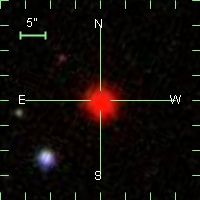Portal:Radiation astronomy/Resource/28
Reds[edit | edit source]

With respect to the color 'red', there are studies of the redness of objects such as the red dwarf AZ Cancri shown in the visual image at right. Cool stars of spectral class M appear red; they are (depending on their size) referred to as "red giants" or "red dwarfs".
"Ideally all intrinsic colours should be found from unreddened stars. This is possible for dwarf and giant stars later than about A0 (Johnson, 1964) ... However, it cannot be used for stars of other spectral classes since they are all relatively infrequent in space, and generally reddened."[1]
A very important wavelength in this region is the Balmer alpha line, 656.28 nm. It is emitted or absorbed by hydrogen atoms when electrons move between the second and third electron shells. Other Balmer lines, known as beta, gamma and delta, have wavelengths of 486.13, 434.05 and 410.17 nm respectively;[1] these are also in the visual range but are less important than the alpha line.
References[edit | edit source]
- ↑ M. Pim FitzGerald (February 1970). "The Intrinsic Colours of Stars and Two-Colour Reddening Lines". Astronomy and Astrophysics 4 (2): 234-43.